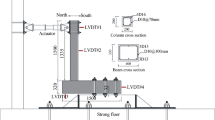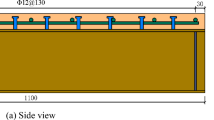Abstract
The debonding characteristics of ultra-high-performance fibre-reinforced concrete (UHPFRC)-strengthened structures under certain loading conditions have been investigated in this paper. Debonding of UHPFRC-strengthened structures seldom occurs owing to the fact that the tensile strength and the stiffness of UHPFRC are similar to that of the concrete substrate. This work concentrates mainly on the strengthening scheme where UHPFRC is provided in the form of strips at the tension zone of concrete. The studies on the effect of normal and shear stresses at the interface of the beam and UHPFRC strip with load increments are essential to determine the scheme of strengthening. The effect of interfacial shear and normal stresses near the strip end was studied by using the Tounsi model which is a modification of Teng model. A comparative study on the variation of the interfacial shear and normal stresses for the beams retrofitted with UHPFRC strip and other repair materials has been carried out. In the present study, the variation of stresses is investigated at two load levels with one load close to the pre-damage load given to the beam and the other load close to the ultimate load. Analytical studies are carried out to study the debonding behaviour of damaged RC beams strengthened with UHPFRC strips under static and fatigue loading. Parametric studies have also been carried out to determine the optimum configuration of the strips to be bonded to the beams.
















Similar content being viewed by others
Abbreviations
- ε 1, ε 2 :
-
Strains at the top and bottom faces of the adhesive
- u 1(x), u 2(x):
-
Longitudinal displacements at the base of concrete and top of UHPFRC layer
- \( \varepsilon_{1}^{M} \), \( \varepsilon_{2}^{M} \) :
-
Strain due to bending moments at the concrete and the UHPFRC layer
- \( \varepsilon_{1}^{N} \), \( \varepsilon_{2}^{N} \) :
-
Strain due to the longitudinal forces at the concrete and the UHPFRC layer
- M 1, M 2 :
-
Bending moments at the concrete and the UHPFRC layer
- N 1, N 2 :
-
Longitudinal forces at the concrete and the UHPFRC layer
- E 1, E 2 :
-
Modulus of elasticity of the concrete and the UHPFRC layer
- I 1, I 2 :
-
Moment of inertia of the concrete and the UHPFRC layer
- y 1, y 2 :
-
Distances from the bottom of the concrete layer and the top of UHPFRC layer to their respective centroids
- \( u_{1}^{N} , u_{2}^{N} \) :
-
Displacement induced by longitudinal force of the respective adherends
- \( \sigma_{p} \) :
-
Axial stress in the plate
- \( \sigma_{c} \) :
-
Axial stress in the concrete prism
- \( \tau\) :
-
Shear stress in the adhesive layer
- t p :
-
Thickness of the plate
- \( t_{c} \) :
-
Thickness of the concrete prism
- \( \tau_{f} \) :
-
Local bond strength
- δ :
-
Interfacial slip, relative displacement between the two adherends
- b p, b c :
-
Width of the plate and the concrete prism
- G f :
-
Interfacial fracture energy
- \( \sigma_{1} \) :
-
Normal stress at the strip
- G c :
-
Interfacial fracture energy
- \( \tau_{f0} ,\tau_{ft} \) :
-
Cycle-dependent bond strengths at time zero and time \( t \) in min
- δ ft :
-
Cycle-dependent slip
- α :
-
Frequency-dependent factor
- P :
-
Load
- Z :
-
Length of the softening zone
- \( m \), \( n \) :
-
Material constants
- β :
-
Fatigue debonding growth coefficient
References
C.K.Y. Leung, Delamination failure in concrete beams retrofitted with a bonded plate. J. Mater. Civ. Eng. 13(2), 106–113 (2001)
W.M. Sebastian, Significance of mid-span debonding failure in FRP-plated RC beams. J. Struct. Eng. 127(7), 792–798 (2001)
P. Wantanasiri, A. Lenwari, Intermediate crack-induced debonding analysis for RC beams strengthened with FRP plates. Struct. Eng. Mech. 56(3), 473–490 (2015)
S.T. Smith, J.G. Teng, Interfacial stresses in plated beams. Eng. Struct. 23(7), 857–871 (2001)
N. Pesic, K. Pilakoutas, Concrete beams with externally bonded flexural FRP-reinforcement: analytical investigation of debonding failure. Compos. Part B Eng. 34, 327–338 (2003)
H.S. Shen, J.G. Teng, J. Yang, Interfacial stresses in beams and slabs bonded with a thin plate. J. Eng. Mech. 127(4), 399–406 (2001)
J.F. Chen, J.G. Teng, Shear capacity of FRP-strengthened RC beams: FRP debonding. Constr. Build. Mater. 17(1), 27–41 (2003)
M. Shahawy, T.E. Beitelman, Static and Fatigue performance of RC beams strengthened with CFRP laminates. J. Struct. Eng. 125, 613–625 (1999)
C.G. Papakonstantinou, P.N. Balaguru, M.F. Petrou, Analysis of reinforced concrete beams strengthened with composites subjected to fatigue loading. ACI Spec. Publ. 206, 41–60 (2002)
Anish, A. Kumar, Ultimate strength analysis of laminated composite sandwich plates. Structure 14, 95–110 (2018)
A. Kumar, A. Chakrabarti, P. Bhargava, V. Prakash, Efficient failure analysis of laminated composites and sandwich cylindrical shells based on higher order zigzag theory. J. Aerosp. Eng. (ASCE) 28, 1–14 (2015)
A. Kumar, A. Chakrabarti, P. Bhargava, R. Chaudhary, Probabilistic failure analysis of laminated sandwich shells based on higher order zigzag theory. J. Sandw. Struct. Mater. 17, 546–561 (2015)
A. Kumar, A. Chakrabarti, Failure analysis of composite skew laminates. Procedia Eng. 173, 1560–1566 (2017)
A.K. Chaubey, A. Kumar, A. Chakrabarti, Novel shear deformation model for moderately thick and deep laminated composite conoidal shell. Mech. Base Des. Struct. Mach. 46, 650–668 (2018)
A. Tounsi, Improved theoretical solution for interfacial stresses in concrete beams strengthened with FRP plate. Int. J. Solids Struct. 43(14), 4154–4174 (2006)
J.G. Teng, H. Yuan, J.F. Chen, FRP-to-concrete interfaces between two adjacent cracks: theoretical model for debonding failure. Int. J. Solids Struct. 43(14), 5750–5778 (2006)
H.M. Diab, Z. Wu, K. Iwashita, Theoretical solution for fatigue debonding growth and fatigue life prediction of FRP-concrete interfaces. Adv. Struct. Eng. 12, 53–65 (2009)
O. Rabinovitch, Y. Frostig, Experiments and analytical comparison of RC beams strengthened with CFRP composites. Compos. Part B Eng. 34(8), 663–677 (2003)
J. Yang, C.F. Chen, J.G. Teng, Interfacial stresses in plated RC beams under arbitrary symmetric load: a higher-order closed form solution, in Proceedings of the first international conference on the use of advanced composites in construction, Southampton University, pp. 153–163 (2002)
F. Yuan, J.G. Teng, R. Seracino, Z.S. Wu, J. Yao, Full-range behaviour of FRP-to-concrete bonded joints. Eng. Struct. 26, 553–565 (2004)
A.R.C. Murthy, M. Aravindan, P. Ganesh, Prediction of flexural behaviour of RC beams strengthened with ultra-high performance fiber reinforced concrete. Struct. Eng. Mech. 65(3), 315–325 (2018)
A.R.C. Murthy, N.R. Iyer, B.K. Raghu Prasad, Characterization and evaluation of micro-mechanical properties of ultra high strength concrete by using micro-indention test. J. Inst. Eng. (India) Ser. A 97(3), 231–238 (2016)
M.A. Carbonell, D.K. Harris, S.V. Shann, T.M. Ahlborn, Bond Strength between UHPC and normal strength concrete (NSC) in accordance with Split prism and freeze & thaw cycling tests, in Proceedings of Hipermat 2012—3rd international symposium on UHPC and nanotechnology for construction materials. Kassel, Germany: Kassel University Press (2012)
G. Upreti, A.R.C. Murthy, G. Smitha, N.R. Iyer, L. Venkat, Strength and ductility of RC beams strengthened with ultra high strength cementitious composite overlay. JOSE, Chennai 43(2), 190–198 (2016)
R. Piyasena, Y.C. Loo, S. Fragomeni, Factors influencing spacing and width of cracks in reinforced concrete: new prediction formulae. Adv. Struct. Eng. 7(1), 49–60 (2004)
Acknowledgements
The authors thank the staff of the Fatigue and Fracture Laboratory and Theoretical and Computational Mechanics Laboratory of CSIR-SERC for the cooperation and suggestions provided during the investigations. This paper is being published with the kind permission of the Director, CSIR-SERC.
Funding
Authors acknowledge the funding provided by UGC-UKERI collaborative project between CSIR-Structural Engineering Research Centre and Cardiff University, UK.
Author information
Authors and Affiliations
Corresponding author
Additional information
Publisher's Note
Springer Nature remains neutral with regard to jurisdictional claims in published maps and institutional affiliations.
Rights and permissions
About this article
Cite this article
Avadhanam, R., Muralidharan, A. & Prakasam, G. Analytical Studies on Debonding Behaviour of RC Beams Strengthened with UHPFRC Overlay. J. Inst. Eng. India Ser. A 100, 241–252 (2019). https://doi.org/10.1007/s40030-019-00364-0
Received:
Accepted:
Published:
Issue Date:
DOI: https://doi.org/10.1007/s40030-019-00364-0




